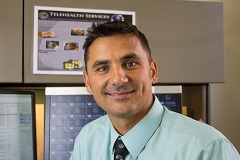For Phoenix VA System, Virtual Medical Room is a ‘Big Success’

For a lot of seniors, trying to adapt to new technology – especially when it stands between patient and physician – is stressful at best.
But the Phoenix Veterans Administration Health Care System has found a more user-friendly way to connect patients and doctors through telemedicine.
The Phoenix VA was one of the centers chosen by the National VA Telehealth Technology Office to test Virtual Medical Rooms (VMRs) to connect patients to their clinicians.
The great advantage to the VMR is that the patient can connect to his or her health-care provider through any home device, including personal computers, laptops, Android phones, iPhones, iPads or other tablets, at a scheduled date and time.
“Patients have been receptive to the VMR technology, because they can use the home device that they are most accustomed to using and are most comfortable with,” said Valentin O. Rivish, RN, MSN, Telehealth specialist and facility e-consult coordinator with the Phoenix VA Health Care System.
“There is no need to obtain or learn new technology.”
 The process begins with both patient and health-care provider receiving an email notification of a scheduled appointment, with a web link. For iPhone and iPad products, a patient or provider connects via an application called Pexip. Once the web link is clicked, the patient is taken to a virtual meeting waiting room. When the provider is ready, the system will connect patient to provider. The patient can skip the virtual waiting room if the provider is ready.
The process begins with both patient and health-care provider receiving an email notification of a scheduled appointment, with a web link. For iPhone and iPad products, a patient or provider connects via an application called Pexip. Once the web link is clicked, the patient is taken to a virtual meeting waiting room. When the provider is ready, the system will connect patient to provider. The patient can skip the virtual waiting room if the provider is ready.
“It’s that simple,” Rivish said.
The only home devices that require downloads are iPad and iPhone products, which require an easy and free download of Pexip.
“It is much easier than how we used to do video-to-home connections between patients and providers. Before, there were several complicated steps to connecting a patient at home with a health-care provider onto a synchronous video encounter.
“Those steps included receiving a long email with instructions to download and install a temporary version of a video software, clicking another link to enter their phone number, which would then open a form that would show details of the appointment, receiving a username and password that had to be copied and pasted into the temporary version of the video software to allow logging in, and so on.
“And patients and providers did not have the luxury of using their smart phones or other portable devices – even if they owned them – and were required to use a desktop or laptop, which not every user had.
“For all these reasons,” Rivish said, “the Virtual Medical Room has been a big success for us.”
